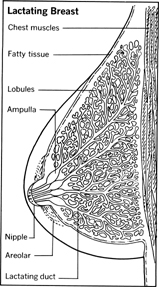Birth, Infancy, and Maturation - Feeding the baby
One of the first questions a mother-to-be must ask herself is how she will feed her baby.
Breast-feeding is certainly the simplest method, and many women believe that both mother and child get more emotional satisfaction from it than from bottle-feeding. It is also, obviously, less expensive.
Breast-Feeding
Almost any healthy woman who wants to breast-feed her baby can do so. All she needs is the desire and motivation. No special preparation is necessary except, perhaps, some stimulation of the breasts, as prescribed by her physician during pregnancy.
On the other hand, a variety of different factors might necessitate a change from breast to bottle-feeding. Although breast-feeding may be discontinued at any time, some mothers may feel a sense of failure or frustration at being unable to continue having the intimate relationship that so many other mothers enjoy. No harm will come to the baby by being switched to a formula. Once started on a formula, however, it may be difficult to go back to breast-feeding on a regular basis. For a while, at least, the mother will have to stimulate her breasts artificially to increase their milk-producing capacity.
The First Few Days
When a mother first starts to breastfeed, she may be worried that she won't have sufficient milk for the baby. Her breasts are just beginning to fill up with a creamy, yellowish substance called colostrum . Transitional and then regular breast milk will not come in for three to five days or longer. Colostrum contains more protein and less fat than breast milk. Secretions of colostrum are small, but during this time the baby does not need very much fluid, and the colostrum will give her adequate nutrition.
Actually, it is important that the milk does not fill the breasts right away because engorgement would be so severe that the baby would not be able to suck well or strongly enough to empty them. During engorgement, the mother's breasts feel extremely tender and full. A good nursing brassiere will lift and support the breasts and alleviate the tender sensation during the one- or-two day period of the engorgement.
Some Advice to Nursing Mothers
If you do not have enough milk for the first few days, don't worry about it. Let the baby suck on your nipples for three, five, or even ten minutes. Don't keep her on your breasts for twenty or thirty minutes right from the beginning. Start with three minutes the first day, five minutes the second, and so on until you work up to fifteen or twenty minutes. In this way you will toughen your nipples so that your breasts will become accustomed to the baby's sucking. A bland cream may be used to massage the nipple area, particularly if the nipples become sore or cracked.

Be sure to use both breasts. By emptying the breasts, milk production is stimulated; thus an adequate milk supply is dependent upon using both breasts. To avoid any soreness or tenderness, use one breast longer than the other during each nursing period.
Let us assume, for example, that at the first feeding of the day you nurse the baby on the left breast for a long period, then on the right for a short period. During the next feeding the right breast will become the first one on which the baby nurses (for the long period), and the left will be nursed second (for the short period). After a few weeks you should be nursing the baby on the first breast for twenty minutes and on the other for ten minutes.
The Feeding Schedule
Depending on how often the baby wants to feed, you will be wise to adhere to a modified demand schedule. Don't watch the clock and feed the baby every four hours on the dot. You might feed at approximately every fourth hour, which means that you could start a second feeding early—at a three-hour interval—or late—at a five-hour interval. And, needless to say, never wake your baby up at night. She will awaken you.
Bottle-feeding
New parents have a choice between prepackaged formulas and the homemade variety. Either provides the same basic nutritional requirements.
The basic homemade formula for newborns consists of evaporated milk, water, and sugar or one of the sugar derivatives. Twice as much water as evaporated milk is used with one to two tablespoons of sweetening. A similar formula can be made with whole milk in somewhat different proportions. As the baby gets older, the formula will be changed from time to time by your physician.
If one formula does not agree with the baby, it will not help to put her on a similar formula; its ingredients are likely to be virtually the same. You must switch to a radically different formula, such as one containing no milk at all or no carbohydrates. It is up to your physician to advise you which modified formula to try.
As to how much formula should be given at each feeding, let the baby decide. If she is satisfied with two-and-a-half ounces, she is probably getting enough. If she wants up to four-and-a-half ounces, give it to her. The amount is not important as long as your physician feels the baby is in good health.
A final thing to remember about feeding is this: whether you use breast or bottle, you must give your baby the love, warmth, and body contact that she needs. As you feed her, you are not only providing nutritional nourishment for her growing body but giving her emotional and mental food for her developing personality.

Comment about this article, ask questions, or add new information about this topic: